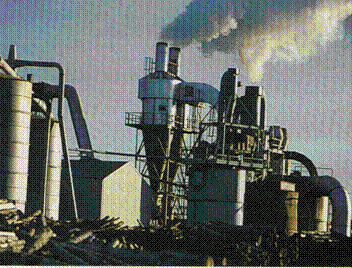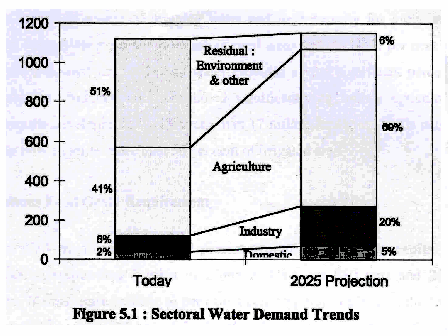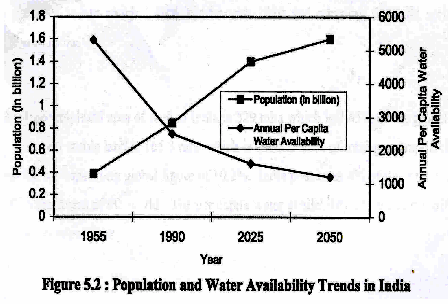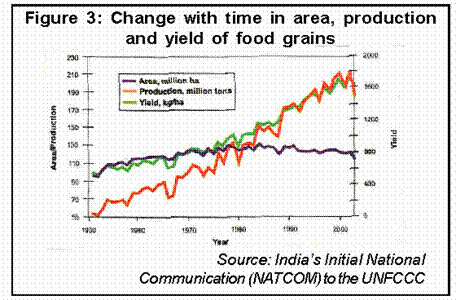| CoP-10 and Sustainable Development: Developing Countries' Perspectives
Kalipada Chatterjee kchatterjee@devalt.org
Developing countries have an extremely low adaptive capacity to withstand the adverse impacts of climate change due to poverty; large population, lack of resources, high dependency on climate sensitive sectors such as water, agriculture, health, biodiversity and energy. The Tenth Conference of Parties must, therefore, ensure that these issues are discussed as a part of the main negotiations between developing and developed nations. G-77 and China and other like thinking nations must come forward and finalise a five year working programme to assist the developing countries to address to these issues urgently, in the context of Climate Change. In this article, the five issues - water, energy, human health, agriculture and biodiversity - are being examined in the Indian context, integrating the latest projections of Climate Change impacts over India. We believe that the issues discussed in this article may be similar in many ways in other developing countries as well.
Water Water is essential for human civilisation, living organisms and natural habitat – for drinking, cleaning, agriculture, transportation, industry, and recreation, animal husbandry, providing electricity for domestic, industrial and commercial use. Due to its multiple benefits and the problem created by its excesses, shortages and quality, water as a resource requires special attention, since it is one of the most important components of sustainable development. The Third Assessment Report of The Inter Governmental Panel on Climate Change (TAR, IPCC, 2001) has depicted the water availability globally. Approximately 1.7 billion people, or one-third of the global population, presently live in countries that are water stressed (defined as those countries using more than 20% of their renewable water supply - a commonly used indicator of water use). The situation may become further critical in many areas due to the projected climate change. India’s Water Resources 1(i) Surface Water: India’s average surface run-off generated by rainfall and snow melt is estimated to be about 1869 billion cubic meters (BCM). It is estimated however that only about 690 BCM or 37% of the surface water resources can actually be mobilised. (ii) Rainfall: The average annual rainfall over India is about 1170 mm. There is considerable variation in rain both temporarily and spatially. (iii) Ground Water: India’s rechargeable annual ground water potential has been assessed at around 431 BCM in aggregate term. On an all India basis it is estimated that about 30% of the ground water potential has been tapped for irrigation and domestic use. India faces an increasingly urgent situation as its finite and fragile water resources are stressed and depleting while various sectoral demands are growing rapidly. In addition, increasing population and rapid urbanisation also put an additional demand on water resources. India’s sectoral water demand trends and population and annual per capita water availability are depicted figures 1 & 2. snow melt is estimated to be about 1869 billion cubic meters (BCM). It is estimated however that only about 690 BCM or 37% of the surface water resources can actually be mobilised. (ii) Rainfall: The average annual rainfall over India is about 1170 mm. There is considerable variation in rain both temporarily and spatially. (iii) Ground Water: India’s rechargeable annual ground water potential has been assessed at around 431 BCM in aggregate term. On an all India basis it is estimated that about 30% of the ground water potential has been tapped for irrigation and domestic use. India faces an increasingly urgent situation as its finite and fragile water resources are stressed and depleting while various sectoral demands are growing rapidly. In addition, increasing population and rapid urbanisation also put an additional demand on water resources. India’s sectoral water demand trends and population and annual per capita water availability are depicted figures 1 & 2. Impact of Projected Climate on Water Resources l Climate Change Impacts on Water Resources2,3Climate plays an important role in water resource availability particularly, the role of south-west monsoon during June-September and north-east monsoon during October and November. The annual precipitation, including snowfall, which is the main source of water in the country, is estimated to be of the order of 4000 km3. Unfortunately, inspite of India receiving an enormous amount of rainfall during the south-west monsoon, a number of states face acute shortage of water and droughts – in fact every year there are media reports of farmers committing suicides due to failure of crops, due to severe droughts. Global warming is projected to increase severity of drought and floods in various parts of India. Overall projection of the impact of climate change / global warming on water resources is that water scarcity will increase with time.
There is an urgent need to integrate with India’s development plans short and long term measures for water harvesting in the drought prone and water scarce regions and plans for flood control by regularly desilting rivers and installing flood warning systems to minimise loss of life and property. But these measures will cost India considerably; however, India finds it difficult to divert already scarce resources from the mainstream activity of poverty eradication. Such issues are important for CoP-10 to discuss, mainly for funds for dealing with issues on water scarcity, droughts and floods and the costs that are needed by each of the developing countries to implement measures.
Energy Energy is one of the most important pillars of the modern economy. One of the Millennium Development Goals is to improve to the billions the access to reliable, affordable, economically viable and environmentally sound energy services. Energy and poverty are very much inter-connected. Modern energy services
enhance the life of the poor in many ways. Electric light particularly for students in the rural India provides extra hours of reading and work, modern cook-stoves save women and children from daily exposure to indoor pollution and refrigeration allows local clinics to keep much needed medicines safe and readily available. Since India is presently aiming at 8% economic growth rate, its energy requirements are bound to increase manifold in the near future, leading to higher emissions of Greenhouse Gases (GHGs). It is clear that the current pattern of energy production, distribution and use are unsustainable. Devising means to reduce the rate of growth of Greenhouse Gas emissions without compromising with the economic development needs in developing countries is a major climate policy challenge. The UN Economic and Social Council (ECSOC) has identified eight key energy sustainability issues: - 1. Accessibility 2. Rural Energy Services 3. Financing of sector improvements 4. Energy Efficiency in production, conversion, distribution and use 5. Advanced technologies 6. Renewable energy 7. Improved energy efficiency and cleaner technologies in the transport sector 8. International co-operation, including greater capacity building investment and technology transfer.
l Climate Change Impacts on EnergyThe energy demand will substantially increase due to higher temperature resulting from climate change particularly in the residential and commercial building sector for space cooling and heating. Many sectors affected by climate change will have direct impacts on energy sector such as the agriculture sector. Irrigation pumps are to be used for longer hours and at more places.
Human Health Current climate trends over India have shown an increase in maximum temperature, droughts, intense rainfall in some areas and emergence of intense cyclones. In the summer of 1994 Western India experienced extreme high temperature followed by heavy rains over Gujarat. The state was also hit by a malaria epidemic. Weather conditions determine malaria transmission to a considerable extent.Heat waves have a much bigger health impact in cities than in rural areas. Adaptation measures can be used effectively to greatly reduce many of the potential health impacts of climate change. The most cost effective and urgently needed measure is to rebuild health infrastructure.
l Basic Services and Health Infrastructure in IndiaThough great strides have been made in areas such as safe drinking water, sanitation etc. i but still the numbers who are not served runs to ten of millions. For example, 170 million people are still constantly vulnerable to vector-borne diseases and there are only 10 hospital beds per 10,000 people. Malaria is one of the most important climate related disease. Besides deaths due to malaria, a large percentage of people particularly the marginal farmers and industrial labourers every year fall sick due to malaria. This is one of the major constraints in on going developmental efforts, particularly in the agriculture sector. National Malaria Control Programme has been successful in bringing down the incidence of malaria.
Agriculture Food grain production in India has increased spectacularly due to green
l Adaptation StrategiesAny disturbance in the agricultural sector can considerably affect the food security particularly to the poor section of the society. Agriculture research needs to be stepped up for finding alternate cultivators (high temperature resistant / drought resistant) for the drought prone areas. In addition, awareness of farmers is to be raised through education, training ad public campaigns. Technology interventions particularly efficient agricultural pumps for irrigation need to be introduced. The traditional agricultural practices are to be analysed and integrated with the State / National policies.
l Need Internationally Funded Studies on Economic Loss Due to Climate Change in Developing CountriesAt present not much reliable data is available to project economic loss to the agriculture sector due to Climate Change. Such projections should be taken up through UN funded projects in developing countries. The international negotiations during CoP 10 must take into account economic losses to the developing countries due to climate change and establish a mechanism to compensate the developing countries for such losses.
Biodiversity & Global Climate Change l Effects on India’s ResourcesWith its rich variety of flora and fauna, India is one of the 12 mega-diversity nations. Global Climate Change may increase the intensity and frequency of extreme weather events such as cyclones and storm surges. Increases in the severity of coastal storms and storm surges could have serious implication for the well being of fishery and aquaculture industry. Increased CO2 concentration, lowers ocean pH which can change ocean carbonate chemistry. This may have negative effects on the planktons that use calcium carbonate to build their skeleton. Some of these organisms appear to play important roles in ocean-atmosphere interaction. At the same time coastal aquaculture (particularly shrimp culture) has resulted in loss of mangrove ecosystem in India. Coastal aquaculture, forest biodiversity, mangroves and coral reefs contribute considerably to India’s economy providing livelihoods to poor. (i) Aquaculture: In case of global aquaculture production, 35% of which is marine, natural climate variability exists independent of anthropogenic climate change, but the two may act in tandem. For e.g. coastal ecosystems are vulnerable to ENSO (a well documented climate variability) cycles because of their effect on distribution of freshwater. (iii) Coral Reefs: Coral reefs are distributed in six major regions along the Indian coastline. These coral reefs would also be at risk from changes in seawater chemistry, temperature and sea level rise. Losses of coral reefs would mean losses in bio-diversity, fisheries and recreational opportunities. Some of the stresses in coral reefs ecosystem are - temperature increase due to global warming, ENSO, diseases, sedimentation, urbanisation and destruction of corals for commercial purposes. l Development & Clean Development Mechanism (CDM)Development is the best adaptation strategy for developing countries to mitigate climate change vulnerability and associated risks. Rapid development also would reduce the total cost due the climate change impacts. Maximising the benefits from CDM would catalyse sustainable development goals viz. social well being, economic well being, environmental well being and technological well being and strengthen adaptability of vulnerable communities. There is an urgent need for India and other developing countries to take up research analysis in these areas to understand clearly the extent of economic loss that the country would suffer due to impacts of climate change on water, energy, health, agriculture and biodiversity. G-77 and China and other like minded nations must come forward during CoP 10 to be held at Buenos Aires and take a decision for implementing a programme under the UNFCCC for a five year action plan in these areas. q
References 1 Initiating and sustaining water sector Reference: WB in collaboration with the ministry of Water Resources, GOI. 2 India’s initial National Communication to UNFCC, MoEF, GoI, 2004. 3 India’s vulnerability to Climate Change, Research Forum, GEP-CCS (USAID Project), 2001 | ||||||


 revolution from 50 Mt in 1951 to 212 Mt in 2002, and the mean cereal productivity increased from 500km ha-1 to almost 1800 per ha-1. These increases were largely the result of area expansion, large-scale cultivation of new high yielding semi-dwarf varieties since 1960s, and the increased application of irrigation, fertilizers and biocides, supported by progressive government policy.
revolution from 50 Mt in 1951 to 212 Mt in 2002, and the mean cereal productivity increased from 500km ha-1 to almost 1800 per ha-1. These increases were largely the result of area expansion, large-scale cultivation of new high yielding semi-dwarf varieties since 1960s, and the increased application of irrigation, fertilizers and biocides, supported by progressive government policy.